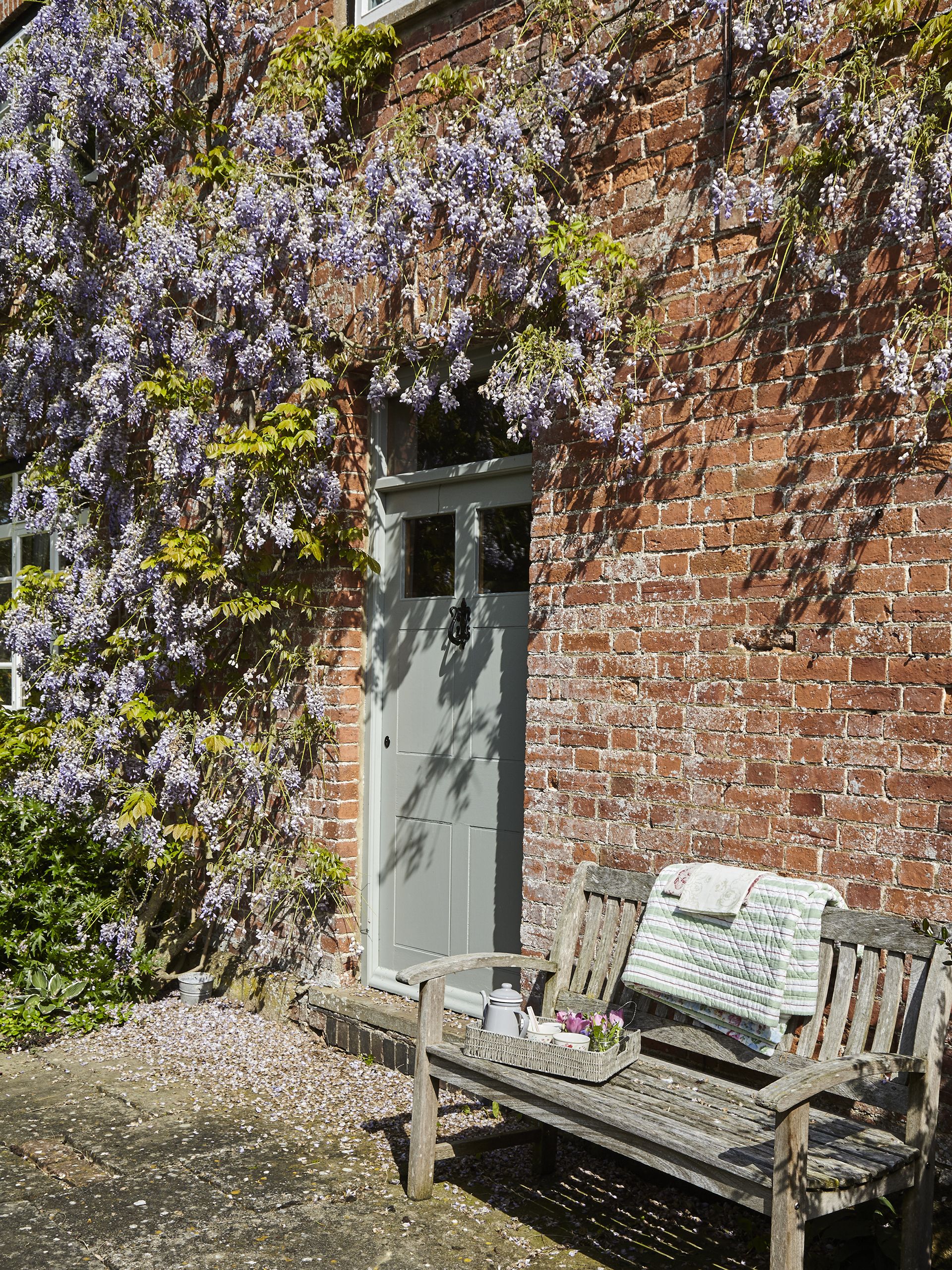How to grow wisteria – where to plant this flowering climber
Learn how to grow wisteria and when and where to plant it to enjoy the wonderful spring and summer blooms of this flowering climber year after year


Decor Ideas. Project Inspiration. Expert Advice. Delivered to your inbox.
Thank you for signing up to Homes & Gardens. You will receive a verification email shortly.
There was a problem. Please refresh the page and try again.
One of the most spellbinding plants for a garden, learn how to grow wisteria and you will enjoy the captivating blooms of this climber every year.
With its long racemes of flowers that clothe walls or pergolas with their color and scent, wisteria is one of the best climbing plants. It is one of the most romantic plants to put on a floral show in late spring into summer, with blooms in white, pink, mauve, blue, and purple; some are strongly scented, while others only have a light fragrance, and vary in their vigor and in the length of their racemes. As a fast growing flowering vine, wisteria must, however, be kept in check to ensure that it doesn't swamp a wall of a house or block pipes and gutters, so you need to know how to prune wisteria to keep it controlled and looking its best. The thick and woody stems will soon bend pipes, strangle trees, and possibly even disturb a house's foundations.
Treated with care, though, wisteria is one of the best flowering climbers you can grow and will last for many, many years. The hanging tails of pea-like blooms can clothe the front of a house to enhance its curb appeal and send their delicious perfume through open windows, or it can scramble over pergolas or smother backyard garden walls with its beautiful spring flowers.
Because some species have become invasive in part of the US, it’s important to learn about these very beautiful plants and how to grow wisteria to contain their vigor before planting them.
How to grow wisteria – the different varieties

‘Wisteria is a long-lived, woody vine that is a quintessential plant of many classic garden designs,’ says Maryland-based landscape architect and designer Kirsten Coffen. ‘But it’s an aggressive, fast grower that requires substantial pruning in late winter to keep it in in check.’
Before we begin the practical instructions on how to grow wisteria, let's talk which wisteria to plant.
Always purchase wisterias that are grafted (grown on rootstock) and come from a reputable supplier.
Forms of Chinese wisteria (W. sinensis) and silky wisteria (W. brachybotrys) are suitable for garden wall ideas and houses; whereas the Japanese wisteria (W. floribunda) is better for covering pergola ideas, where its very long racemes will not be covered by foliage.
Of the Japanese forms, ’Yae-kokuryu’ is a traditional purple variety; ‘Shiro-noda’ is an elegant white; the pink ‘Hon-beni’ would be at home in a cottage garden scheme; and the very long (up to 4ft/1.2m) racemes of ‘Kyushaku’ are white and violet.
If you live in one of the US states where W. sinensis or W. floribunda have become invasive plants (such as Virginia or North Carolina), it’s not advised to grow them or their more vigorous cultivars, unless you are prepared to keep them in careful check with pruning.
Instead, when looking at how to grow wisteria, choose one of the less aggressive cultivars, such as the beautiful white ‘Jako’, or opt for an American wisteria, such as W. frutescens ’Amethyst Falls’, which won’t strangle forests if it escapes from your garden. Other relatively compact options include W. frutescens var. macrostachya ‘Blue Moon’ and ‘Aunt Dee’, which both smell of sweet peas.
‘I have found success using the American native form of wisteria (W. frutescens 'Amethyst Falls'),’ says Connecticut-based landscape-designer Donna Christensen. ‘It is not as aggressive as the Chinese or Japanese forms. The fragrant purple flowers are a bit smaller and slightly tighter. However, I find it to bloom longer, and it is less inclined to take over. I use it where I want a soft sweep of fragrance and color over a mid-size arbor. It also blooms a little later than the Asian forms and sends out fewer runners. I have combined it with Asian varieties on a larger pergola for an extended bloom period, too.’
Thankfully, in many parts of the US and in the UK, wisteria is not an invading pest and easy to manage.

When to plant wisteria
The exact time to plant wisteria may differ depending on the hardiness zone where you live, but in many areas you will be looking to plant it between October and April, on a day when the ground is not frozen or waterlogged. This might be at the same time as you're planting climbing roses and other bare root plants.
Where is the best place to plant wisteria?
The best place to plant wisteria is where it can scramble up a support and its fragrant flowers can be enjoyed to the full.
‘Its beautiful spring-blooming cascade of purple, or white, fragrant flowers is best viewed when trained on a support, such as a sturdy pergola,’ says Kirsten Coffen.
Such a leafy, flowery canopy provides blissful shade in the heat of summer and is an ideal pergola shade idea. ‘We plant wisteria on rooftops in the city, training it to cover pergolas in order to provide shade,’ says Irene Kalina-Jones, landscape designer at Outside Space NYC in New York City. ‘But I also like it grown against buildings.’
It's best to grow wisteria in a sheltered site in full sun, such as a south or west-facing facade. The soil must be fertile and well-drained, so dig in plenty of organic matter, such as homemade compost upon planting.
If growing wisteria up a wall or the front of a house as a front garden wall idea, take the time to erect a sturdy frame for the wisteria to climb – potentially, over many decades. Wooden trellis can rot, so a tensioning system of wires is arguably better. The wires must tighten themselves as the plant puts on weight or be easy for you to tighten – via turnbuckles, for instance.

What is the best way to grow wisteria?
For how to grow wisteria successfully, follow these step by steps to start it off well. The method is that for planting bare root trees and shrubs:
1. Soak the wisteria
Soak the wisteria for an hour before planting by sitting the base of the pot in water.
2. Dig a hole of the correct size
While the wisteria is soaking, dig a hole at least 3ft (90cm) away from the wall it is going to climb. The hole ought to be 2-3 times wider than the wisteria’s container.
3. Loosen the soil, add compost
Loosen the soil at the bottom of the hole well with a fork, and dig in organic matter, such as compost.
4. Position the wisteria
Check the position of the graft – the bulbous union between the roots and the main stem – is above the ground.
5. Plant the wisteria
Backfill with soil, and firm in to prevent air pockets. Then, water in.
How to grow wisteria in containers
If you're wondering how to grow wisteria in a small garden, ’it is possible to plant wisteria in a pot,’ says California-based garden designer Laura Morton. ‘I provide some support, like bamboo canes, and prune hard. I select the best 3-4 vines to establish structure and secure them into place with the stakes (say one at 1 o’clock another at 5, and another at 10). Then they get pruned to 2-4 foot. Over time I prune lateral 'streamers' to 3-5 buds (because that’s where they bloom in year 2) and remove suckers from the base.’
Grown in a pot, it is easier to keep a wisteria under control.

How do you train wisteria to climb?
Wisteria may be the queen of climbers as a vertical garden idea, but a queen can rule with an iron fist. Don’t be fooled by the cascade of softness: wisterias will swallow your house whole, if you let them.
Staring up at a mature wisteria in full bloom, it resembles a purple waterfall flowing over the front of the house. These plants are beautiful, mighty beasts that require twice yearly pruning to keep them in check. It’s worth going to see a sizeable old wisteria – such as those in Sierra Madre, California and Knole in Kent, England – both for the delight of seeing them, but also to realise their vigor.
‘I love wisteria for the fat buds in spring and the voluptuous scented cascades that follow, but it must be wrangled so as not to overwhelm,’ warns Laura Morton. ‘I often anchor individual vines to a wall to create a tracery in a pattern. This makes it easier to keep under control.’ The tracery will also stand out and look striking in winter.
Allow a new, young wisteria to climb to the top of the structure or wall you intend it to flower upon. Then begin to prune and tie in strong side stems horizontally, which will eventually create a whole wall of flowers, rather than just a mass of flowers at the top. It’s best to tie with flexible tubing ties that stretch as the plant grows, and to repeatedly untie and retie stems to prevent them becoming attached to the wires.
‘Since wisteria requires regular pruning, my main advice to those looking for a low-maintenance garden is: do not plant wisteria,’ says Irene Kalina-Jones, landscape designer at Outside Space NYC. ‘Only plant it if you have time to prune it and if you are a gardener or are prepared to hire someone to do it for you. If it isn’t pruned twice a year, it is a pest. I’ve taken enough of them out of back yards where they have escaped and turned into a nuisance, due to a lack of pruning.’
How long does it take for a wisteria to flower?
A baby wisteria may not flower for a few years after planting. To care for young wisteria plants and to ensure flowering, water them regularly and generously during their first two seasons, especially in drought or if the ground where they are planted is dry. Feed every spring with a general-purpose fertiliser until established, but never over-feed.

How long does wisteria take to grow?
Wisteria are quick to grow – growing up to 10 feet or more a year. This makes them a wonderful choice when you are looking for garden privacy ideas or garden shade ideas, as they will be in full leaf throughout the summer months. However, it also means that you have to be vigilant about pruning if you don't want them to take over your back yard or the outside of your house.
What does wisteria look like in winter?
True wisteria are deciduous, so will lose their leaves during the colder months. They are at their peak in spring and summer, when clothed in foliage and flowers, but once established, the thick woody stems of wisteria can still add interest to walls and structures even during fall and winter.
Sign up to the Homes & Gardens newsletter
Decor Ideas. Project Inspiration. Expert Advice. Delivered to your inbox.

Lucy Searle has written about interiors, property and gardens since 1990, working her way around the interiors departments of women's magazines before switching to interiors-only titles in the mid-nineties. She was Associate Editor on Ideal Home, and Launch Editor of 4Homes magazine, before moving into digital in 2007, launching Channel 4's flagship website, Channel4.com/4homes. In 2018, Lucy took on the role of Global Editor in Chief for Realhomes.com, taking the site from a small magazine add-on to a global success. She was asked to repeat that success at Homes & Gardens, where she has also taken on the editorship of the magazine.
-
-
 Levoit 36-Inch Tower Fan review: powerful cooling
Levoit 36-Inch Tower Fan review: powerful coolingThe Levoit 36-Inch Tower Fan offers powerful cooling paired with four helpful modes, including the ability to sense and respond to room temperatures.
By Paige Cerulli Published
-
 Mia Farrow's porch color has a 'subtle yet undeniable allure' that real estate agents say could 'exceed expectations'
Mia Farrow's porch color has a 'subtle yet undeniable allure' that real estate agents say could 'exceed expectations'Real estate experts say this 'serene and welcoming' hue could be a 'game-changer' when selling our property
By Megan Slack Published

